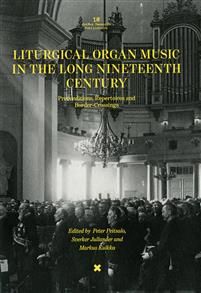The long nineteenth century was an era of transition, paradoxes and conflict in the area of church music. A time of continuing decline in the position of the church and the organ in musical life, it also saw the birth of several reform movements relating to liturgy, organ and church music movements that not only shaped many of the developments in the following century but have also had significant repercussions on present-day practices. Far from being neglected, the use of the organ in the liturgy received a great deal of attention and was intensely debated in nineteenth-century publications. The Sibelius Academy Docmus doctoral school is publishing a new anthology in order to shed light to these phenomena. The collection of articles is based on presentations held in January 2016 during an international conference Liturgical organ music and liturgical organ playing in the long nineteenth century.
The essays in the anthology Liturgical Organ Music in the Long Nineteenth Century: Preconditions, Repertoires and Border-Crossings deal with various forms of liturgical organ music and liturgical organ-playing in the long nineteenth century: solo repertoires, accompaniment of congregational singing, plainchant and other liturgical vocal music, as well as non-liturgical organ music echoing liturgical practices. Important thematic strands in the volume include: Historical preconditions: the forms and practices of organ music in relation to the various kinds of liturgical singing, influential liturgical and aesthetic ideals, as well as theological, philosophical, ideological and social contexts; Border-crossing: how liturgical-musical practices and repertoires transcended confessional, regional and national boundaries. Special attention has been given to the central, northern and eastern regions of Europe.
Contributors to the publication are Michael Heinemann, Maria Helfgott, Sverker Jullander, Samuli Korkalainen, Martti Laitinen, Jan Lehtola, Benedikt LeSsmann, Kurt Lueders, Krzysztof Lukas, Jonas Lundblad and Peter Peitsalo.
The long nineteenth century was an era of transition, paradoxes and conflict in the area of church music. A time of continuing decline in the position of the church and the organ in musical life, it also saw the birth of several reform movements relating to liturgy, organ and church music movements that not only shaped many of the developments in the following century but have also had significant repercussions on present-day practices. Far from being neglected, the use of the organ in the liturgy received a great deal of attention and was intensely debated in nineteenth-century publications. The Sibelius Academy Docmus doctoral school is publishing a new anthology in order to shed light to these phenomena. The collection of articles is based on presentations held in January 2016 during an international conference Liturgical organ music and liturgical organ playing in the long nineteenth century.
The essays in the anthology Liturgical Organ Music in the Long Nineteenth Century: Preconditions, Repertoires and Border-Crossings deal with various forms of liturgical organ music and liturgical organ-playing in the long nineteenth century: solo repertoires, accompaniment of congregational singing, plainchant and other liturgical vocal music, as well as non-liturgical organ music echoing liturgical practices. Important thematic strands in the volume include: Historical preconditions: the forms and practices of organ music in relation to the various kinds of liturgical singing, influential liturgical and aesthetic ideals, as well as theological, philosophical, ideological and social contexts; Border-crossing: how liturgical-musical practices and repertoires transcended confessional, regional and national boundaries. Special attention has been given to the central, northern and eastern regions of Europe.
Contributors to the publication are Michael Heinemann, Maria Helfgott, Sverker Jullander, Samuli Korkalainen, Martti Laitinen, Jan Lehtola, Benedikt LeSsmann, Kurt Lueders, Krzysztof Lukas, Jonas Lundblad and Peter Peitsalo.













